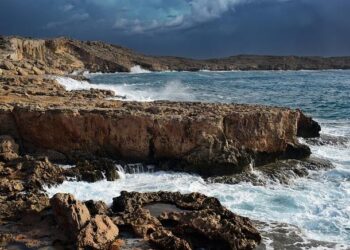A new analysis by World Weather Attribution reveals that the weather conditions driving the recent deadly wildfires in TĂĽrkiye, Cyprus, and Greece have become up to ten times more likely due to the impacts of climate change. The study highlights how rising temperatures and prolonged dry spells have intensified the risk of extreme fire weather in the Eastern Mediterranean region, underscoring the growing threat posed by global warming. As communities grapple with the devastating aftermath, experts warn that such climate-driven disasters may become increasingly frequent and severe if urgent mitigation efforts are not implemented.
Weather Patterns Behind Devastating Wildfires in TĂĽrkiye Cyprus and Greece
The recent spike in wildfires across TĂĽrkiye, Cyprus, and Greece has been strongly linked to a combination of prolonged heatwaves, reduced precipitation, and abnormally dry conditions. Meteorological analyses reveal that these weather extremes have created an environment ripe for rapid fire ignition and spread, with temperatures soaring well above historical averages. World Weather Attribution emphasizes that such conditions, characterized by extended droughts and intense heat, have become nearly ten times more likely due to the overarching influence of climate change. This alarming trend highlights how shifting atmospheric patterns and ocean temperatures play a decisive role in amplifying fire risks in the Eastern Mediterranean region.
Key weather variables contributing to the wildfire crisis include:
- Persistent heatwaves elevating average temperatures by 3-5°C
- Significant drops in rainfall impairing soil and vegetation moisture
- Stagnant high-pressure systems trapping hot, dry air masses
- Strong, dry winds facilitating fast fire spread
The table below summarizes the comparative change in these factors during the critical wildfire season:
| Weather Factor | Historical Range | 2023 Extremes | Climate Change Impact |
|---|---|---|---|
| Average Temperature Increase | 28-32°C | 35-38°C | +3-5°C (10x likelihood) |
| Rainfall Volume | 50-70 mm | 15-30 mm | -60% (drier soils) |
| Days Without Rain | 10-15 days | 25-30 days | +100% (extended drought) |
| Wind Speed | 10-15 km/h | 20-30 km/h | +50% (fire spread catalyst) |
Scientific Analysis Links Climate Change to Increased Wildfire Risks
Recent scientific investigations have firmly linked the extreme weather conditions that fueled devastating wildfires in TĂĽrkiye, Cyprus, and Greece to anthropogenic climate change. According to the World Weather Attribution group, the combination of severe heatwaves, prolonged drought, and dry winds created an environment where such fires became exponentially more likely – roughly 10 times more probable than in a pre-industrial climate. This stark increase underscores how human-driven warming is amplifying natural hazards, directly impacting ecosystems, public health, and regional economies.
Data analysis reveals several critical factors influencing wildfire risks in the region:
- Temperature anomalies: Summer highs were consistently above historical averages, intensifying vegetation dryness.
- Soil moisture deficits: Extended drought periods drastically reduced natural barriers to fire spread.
- Wind speed fluctuations: Strong gusts increased fire propagation rates, overwhelming containment efforts.
| Factor | Pre-Industrial Probability | Current Probability |
|---|---|---|
| Heatwave Occurrence | 1% | 10% |
| Drought Severity | 2% | 18% |
| Wind Force Impact | 3% | 25% |
Urgent Call for Enhanced Fire Prevention and Climate Resilience Measures
The recent catastrophic wildfires that devastated vast regions of TĂĽrkiye, Cyprus, and Greece highlight a grim reality: climate change has dramatically amplified the frequency and intensity of extreme weather events. According to findings by World Weather Attribution, these deadly conditions-marked by soaring temperatures, prolonged droughts, and shifting wind patterns-are now ten times more likely than in previous decades. This alarming increase calls for an immediate overhaul in fire prevention strategies, prioritizing both enhanced infrastructure and community preparedness to withstand escalating natural threats.
Key areas requiring urgent attention include:
- Strengthened early-warning systems leveraging advanced meteorological data.
- Expansion of controlled burns and vegetation management to reduce fuel loads.
- Investment in resilient infrastructure, including fire-resistant building materials.
- Community engagement programs to educate and equip locals for emergency response.
| Measure | Expected Impact | Timeline |
|---|---|---|
| Smart Fire Detection Networks | Rapid identification and response | 1-2 years |
| Vegetation Clearance Policies | Decrease in fire fuel sources | Ongoing |
| Community Training Programs | Improved local resilience | 6 months – 1 year |
To Conclude
As wildfires continue to ravage TĂĽrkiye, Cyprus, and Greece with increasing intensity, this new analysis from World Weather Attribution underscores the stark role of climate change in amplifying extreme weather conditions. With the likelihood of such deadly heatwaves and droughts now ten times higher than in the past, experts warn that urgent measures are needed to address both climate mitigation and wildfire preparedness. The findings serve as a sobering reminder that the risks of natural disasters are escalating across the Mediterranean, demanding coordinated action from governments, communities, and the international community alike.
















